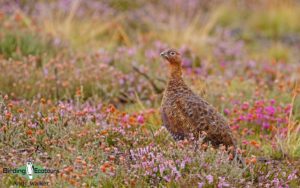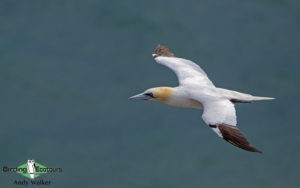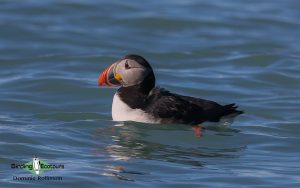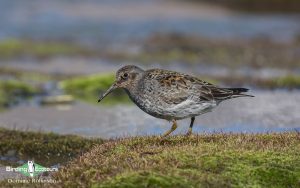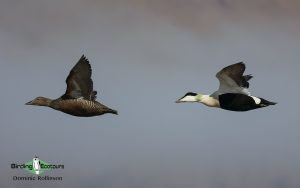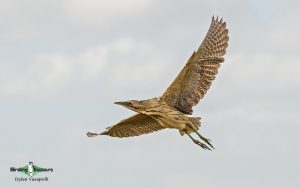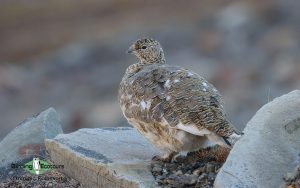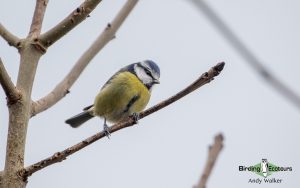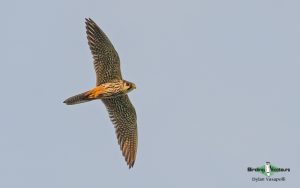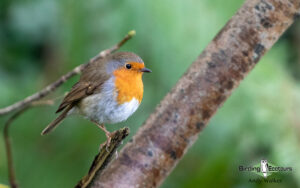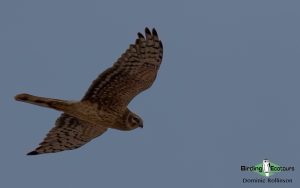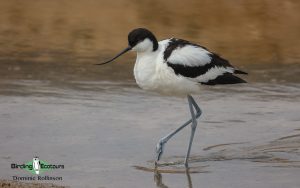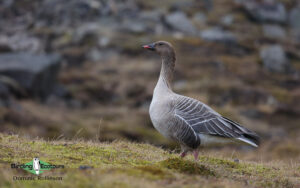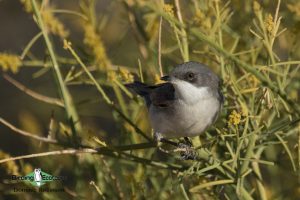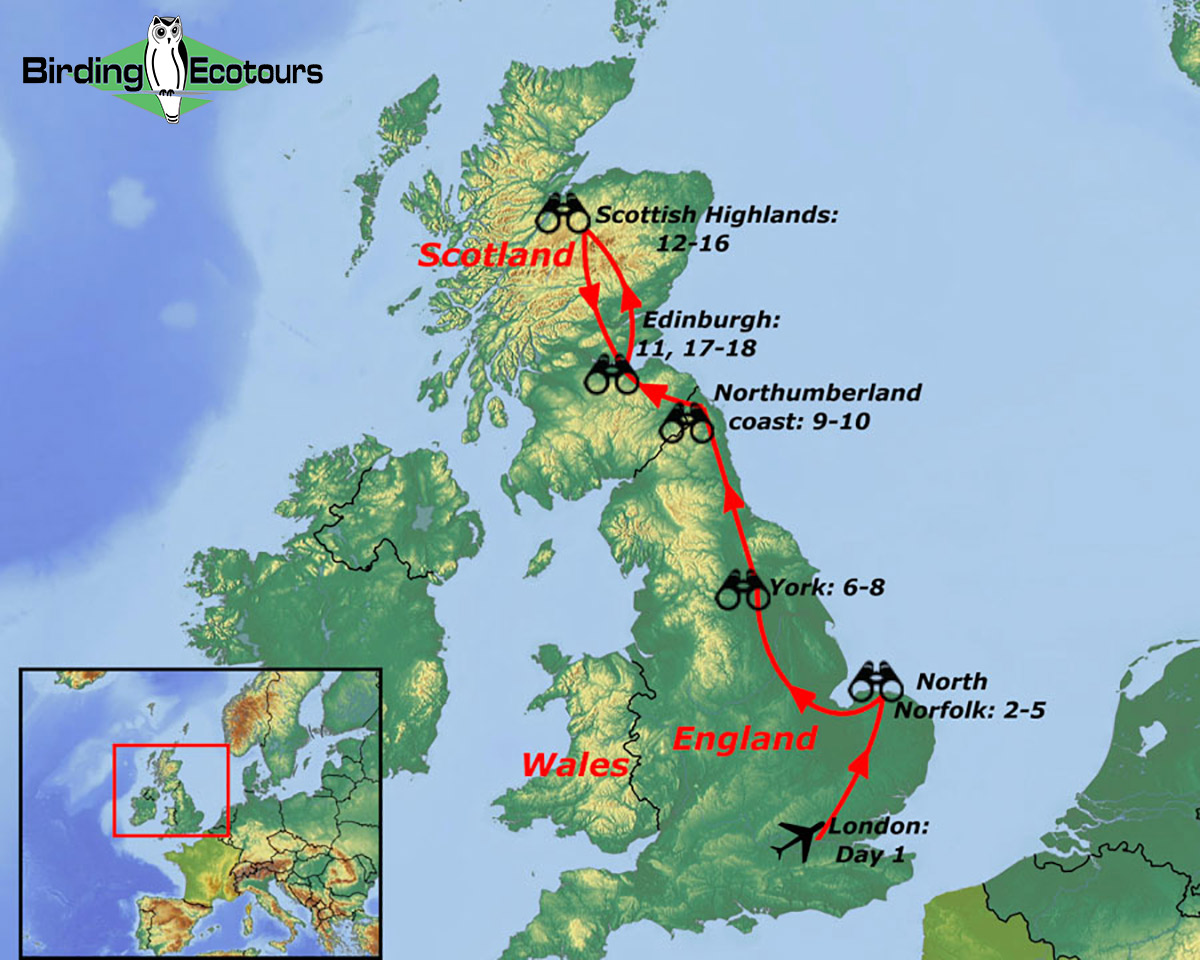United Kingdom Birding Tour: England and Scotland in Spring
Go to: Norfolk Birding Day Trips | Suffolk Day Tours | United Kingdom Birding Tours | Birding Tours in Europe | All our birding tours
United Kingdom Birding Tour: England and Scotland in Spring
May 2025/2026
The islands of the United Kingdom are situated on the northwestern fringes of the European (and Western Palearctic) region, and as such the birdlife is influenced by a range of geographical and climatic factors. This small group comprehensive United Kingdom birding tour starts in the south of England (London), finishes in Scotland (Inverness), and is timed during the peak of the spring migration within the United Kingdom, when breeding for many species will also be well underway.
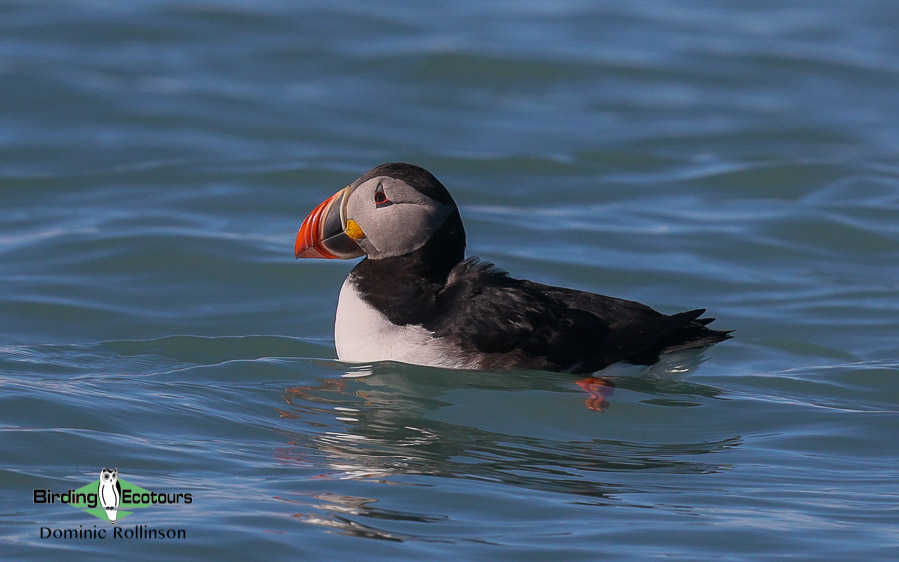
A number of bird species are resident and common (and spectacular to the visiting birdwatcher or bird photographer), such as European Robin, Eurasian Blue Tit, Great Tit, European Nuthatch, Long-tailed Tit, European Goldfinch, Eurasian Bullfinch, Common Wood Pigeon, Willow Ptarmigan (Red Grouse), Yellowhammer, Northern Lapwing, and European Green Woodpecker. We have put together a detailed “Common Birds of the UK” blog series presenting a photographic look at the common garden, farmland and woodland, and wetland and coastal birds of the UK. These common resident and migrant species will also add great value to our tour and are sure to delight.
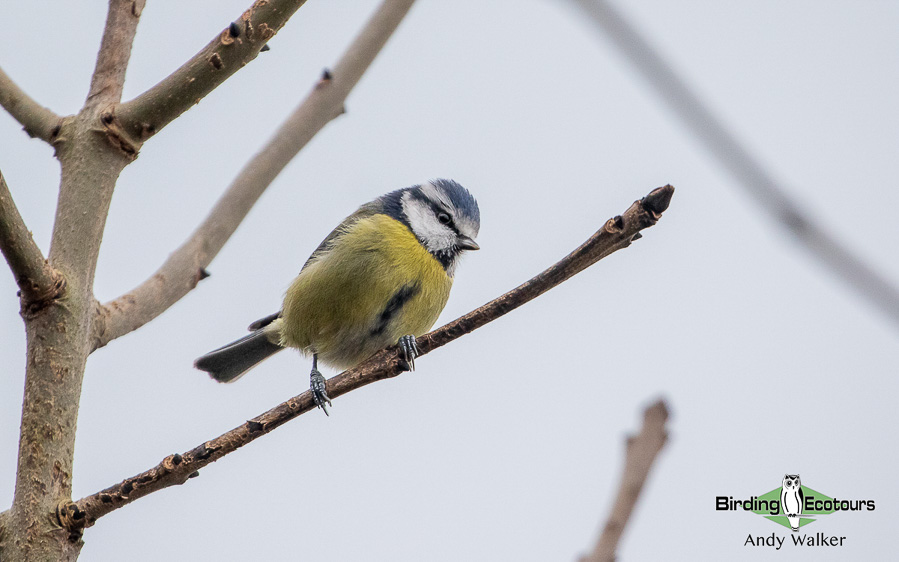
There are a large number of rare, scarce, or very local breeding species in England, and we will target as many of these as possible during this England and Scotland birding tour, such as Bearded Reedling (Bearded Tit), Eurasian Bittern, Red Kite, European Honey Buzzard, Western Marsh Harrier, Montagu’s Harrier, Hen Harrier, Eurasian Hobby, Garganey, European Turtle Dove, Ruff, Black-tailed Godwit, Corn Crake, Common Quail, European Nightjar, Eurasian Spoonbill, Eurasian Stone-curlew, Black Grouse, Mediterranean Gull, Little Tern, European Nightjar, Eurasian Woodcock, Short-eared Owl, Long-eared Owl, Dartford Warbler, Common Nightingale, Common Kingfisher, and Common Crane.
Some birds are restricted to, or only breed in, the Scottish Highlands and coastal portion of our United Kingdom birding tour. These include Scottish Crossbill (a Scottish endemic), Parrot Crossbill, Rock Ptarmigan, breeding Red-throated Loon (Red-throated Diver), Common Loon (Great Northern Diver), Golden Eagle, White-tailed Eagle, Horned Grebe (Slavonian Grebe), Black Guillemot, Eurasian Dotterel, Snow Bunting, and European Crested Tit.
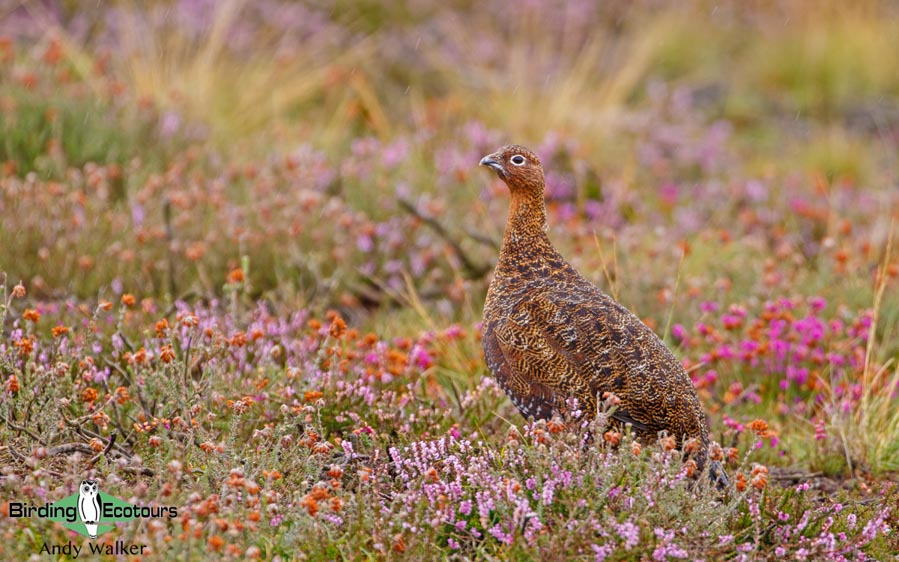
As this England and Scotland bird watching tour will take place during the spring passage period, our time at the coast could be interrupted by a scarce migrant such as European Bee-eater (a handful of these actually started breeding in Norfolk in 2022), Red-backed Shrike, or Icterine Warbler, or something altogether much rarer. Spring rarities in the United Kingdom can come from far-flung places such as the United States of America, the Mediterranean and Eastern Europe, or Siberia, so almost any migratory species could be on the cards!
Itinerary (18 days/17 nights)
Day 1. Arrival in London and transfer to a hotel near the airport
After our arrival in London (Heathrow) we will transfer to our hotel and gather for our group evening welcome meal together. If you would like to explore the many tourist attractions of the city of London (Westminster Abbey, Buckingham Palace, Houses of Parliament and Big Ben, Kew Gardens, Natural History Museum, etc.) please organize an early arrival into the United Kingdom (we will not be ending the tour back in London). We can help arrange your plans if you would like to partake in any additional activities prior to the beginning of the birding tour.
Overnight: Heathrow Airport area, London
Day 2. Transfer to North Norfolk
We will leave the Heathrow area after breakfast and will commence our journey to North Norfolk, our base for the next four nights. Birding near London may get our lists going with some of the many exotic species present in the United Kingdom, such as Rose-ringed Parakeet, Mandarin Duck, or Egyptian Goose. We will also likely see the first of the common species that we will see over the course of our birding tour, such as European Robin, Eurasian Blue Tit, Great Tit, European Goldfinch, Common Wood Pigeon, and Eurasian Magpie.
On arrival in Norfolk, we will likely get our birding underway at one of the many nearby birding sites described below.
Overnight: North Norfolk
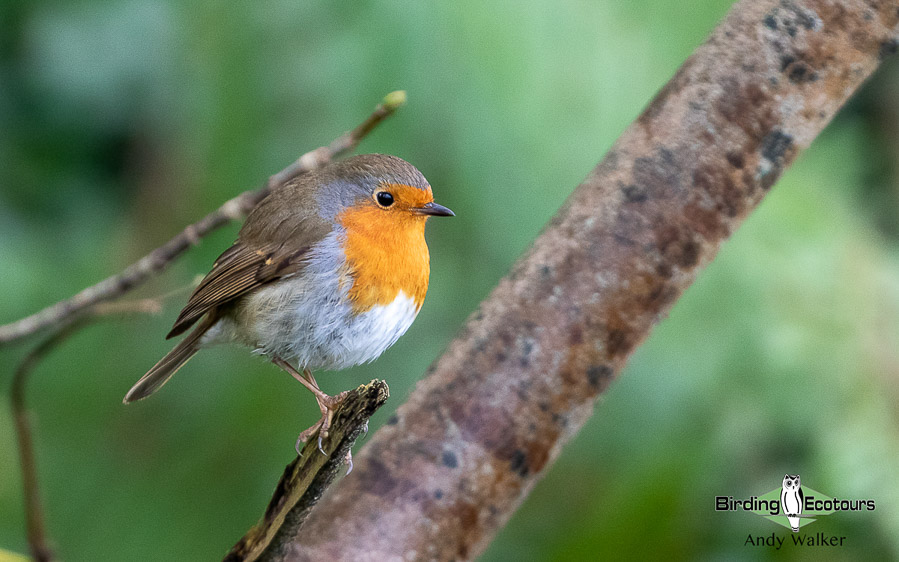
Days 3 – 5. North Norfolk birding
We will spend three full days at a selection of Norfolk birding sites and in adjacent counties as we explore East Anglia, one of the best birding areas in the whole of the United Kingdom. East Anglia is great for a varied selection of restricted-range breeding birds and has a fantastic reputation for spring passage migrants and rarities. Some of the coastal and inland reserves we can visit during our time in the area include Royal Society for the Protection of Birds (RSPB) Titchwell Marsh, RSPB Lakenheath Fen reserve, and Norfolk Wildlife Trust (NWT) Cley Marshes, among others.
We will visit vast areas of saltmarshes, freshwater marshes, inland and coastal wetlands, and estuaries that could be teeming with passage shorebirds changing color into their gorgeous breeding plumage as they head north. Some of these include Curlew Sandpiper, Wood Sandpiper, Temminck’s Stint, Common Ringed Plover, European Golden Plover, and Dunlin, as well as several raptors such as Western Marsh Harrier and the now very rare, Montagu’s Harrier.
The water and its surrounding edge habitat are likely to hold a wide array of breeding ducks (e.g. Common Shelduck, Tufted Duck, Garganey, and Mandarin Duck) along with a mix of wading birds like Pied Avocet, Little Ringed Plover, Eurasian Bittern, Eurasian Spoonbill, Little Egret, Grey Heron, and Water Rail. Reedbeds in the area may hold Sedge Warbler, Common (Eurasian) Reed Warbler, and Bearded Reedling (Bearded Tit) and scrubland may support the prized Common Nightingale, Cetti’s Warbler, and Dartford Warbler.
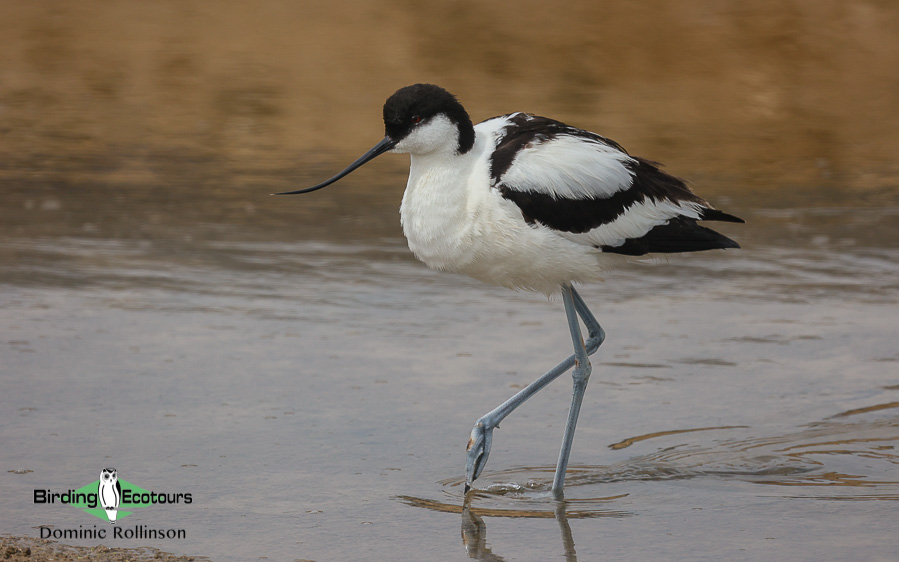
We will spend some time inland in the Brecks, where we may find breeding Eurasian Stone-curlew, Common Crane, Eurasian Bittern, Common Kingfisher, Water Rail, Woodlark, Common Firecrest, European Green Woodpecker, Eurasian Goshawk, Red Crossbill (Common Crossbill), Little Owl, Eurasian Hobby, Little Egret, Western Yellow Wagtail, White Wagtail (Pied Wagtail), and maybe even the now-rare Lesser Spotted Woodpecker.
The above is just a small selection of the birds we will encounter and places we will bird during our time in Norfolk to give some idea of what we might find.
Overnight: North Norfolk (three nights)
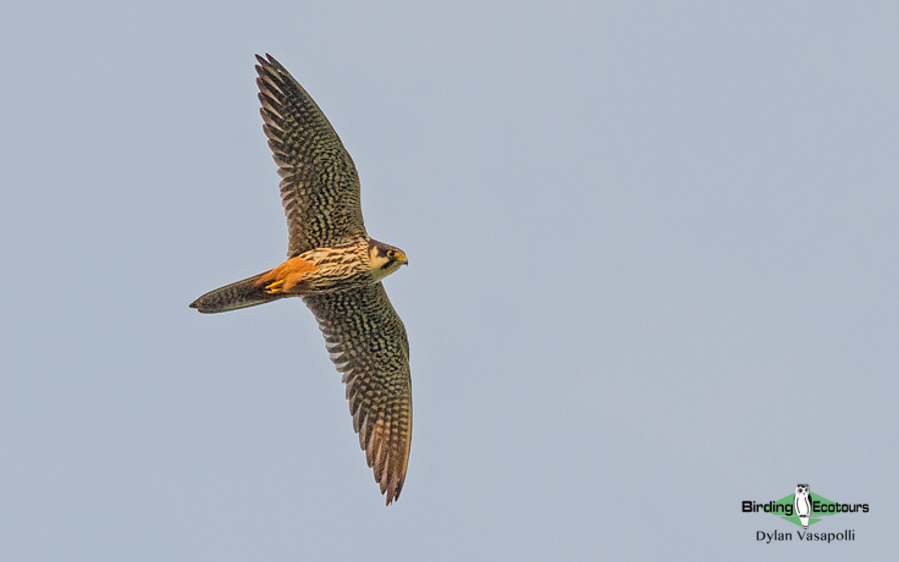
Day 6. Transfer between North Norfolk and the City of York
This will be a travel day as we move between North Norfolk and the City of York after our final early-morning birding session in the area. York will be our base for the next three nights as we spend time birding in Yorkshire. York, the former Roman capital of the north of England, is a walled city and has some very impressive buildings, none more so than York Minster, although Clifford’s Tower and ‘the Shambles’ (an ancient street) also take some beating. We will have some time to see these areas while we are in the city. We will spend an evening (either tonight or one of the following nights) looking for a range of crepuscular or nocturnal species, such as European Nightjar, Long-eared Owl, Tawny Owl, Little Owl, Western Barn Owl, and Eurasian Woodcock, not far from the city itself.
Overnight: York
Days 7 – 8. Yorkshire birding
We will spend two full days birding around the county of Yorkshire. We will focus our attention near our base in the farmed landscape of the Vale of York and the surrounding hills (the Chalk Wolds). This patchwork of arable and pastoral farmland (many areas managed specially for flora and fauna) interspersed with woodland and ‘common land’ forms an incredibly important mosaic of habitats, and here we may find European Turtle Dove (now regrettably a rare breeding bird in the country).
Other species we will search for around York include Western Barn Owl, Western Marsh Harrier, Red Kite, Common Kestrel, Common Buzzard, Eurasian Hobby, Peregrine Falcon, Northern Lapwing, Eurasian Whimbrel, Common Redshank, Common Snipe, Corn Bunting, Common Reed Bunting, Yellowhammer, Marsh Tit, Willow Tit, Goldcrest, Common Whitethroat, Lesser Whitethroat, Great Spotted Woodpecker, Eurasian Skylark, Common Linnet, European Goldfinch, Red-legged Partridge, Grey Partridge, Common Pheasant, Rook, Western Jackdaw, Carrion Crow, Common House Martin, Sand Martin, Common Swift, Common Cuckoo, Dunnock, Song Thrush, Mistle Thrush, Common Blackbird, Common Chaffinch, and Eurasian Tree Sparrow.
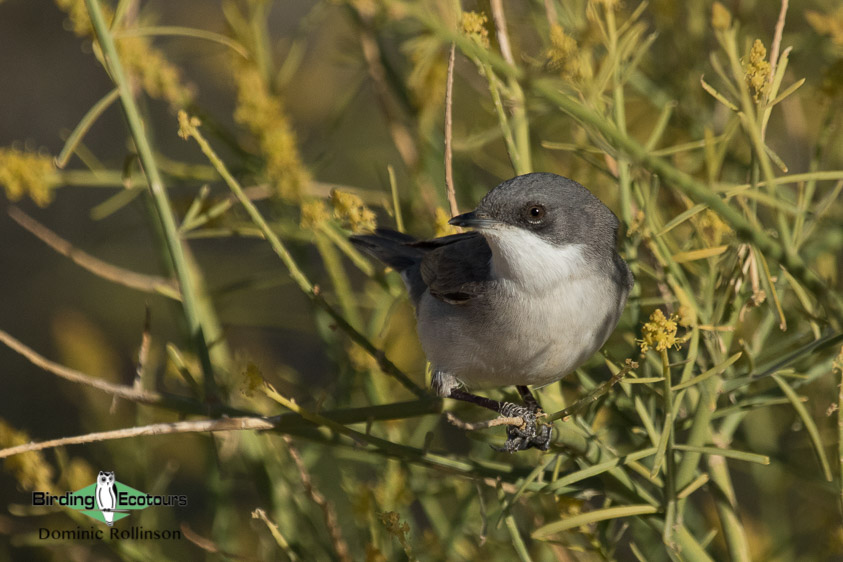
Part of the farmland in the Vale of York is a seasonally flooded wetland, and depending on water levels during the preceding winter there may be some bonus birds within the area we will be birding, such as Black-necked Grebe, Ruff, Black-tailed Godwit, Spotted Crake, Garganey, Corn Crake, Common Quail, Common Tern, or Black Tern.
Moving further from the city of York, one of the must-see places on the Yorkshire Coast is Bempton Cliffs RSPB reserve. Here huge and staggering sea cliffs will be packed with returning breeding seabirds like Common Murre (Common Guillemot), Razorbill, European Shag, Black-legged Kittiwake, Northern Fulmar, and Northern Gannet. There may even be our first chance of seeing the gorgeous (and clown-like) Atlantic Puffin, and likely European Herring Gull, Great Black-backed Gull, Lesser Black-backed Gull, Great Skua, and Peregrine Falcon will all be patrolling the sea cliffs, looking for an easy meal.
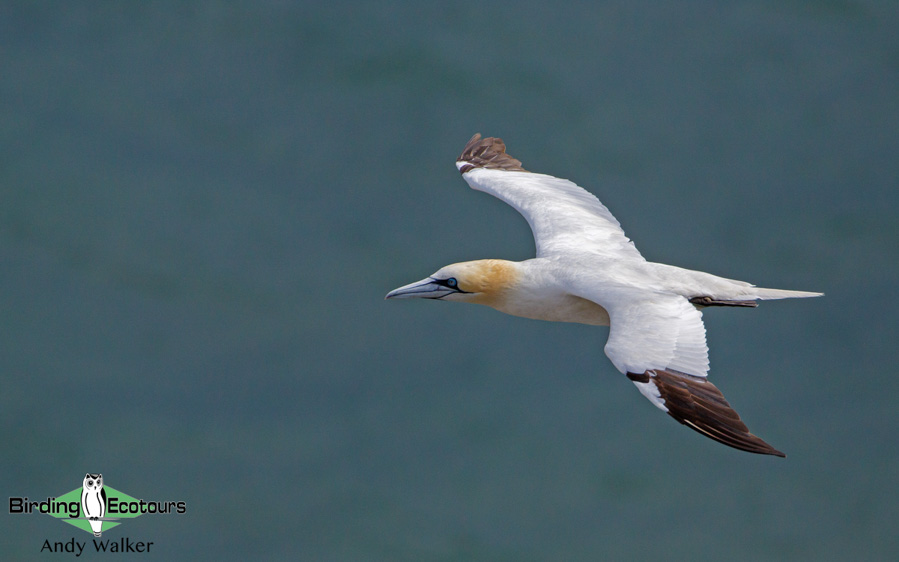
While we are at the coast we will need to keep an eye out for passage migrants; anything could turn up here at this time of year from the likes of White Stork to Eurasian Hoopoe to Eurasian Wryneck. None of these are necessarily to be expected, but with spring migration you never exactly know, and this area has a track record of rare birds turning up! However, birds like Wood Warbler, Common Redstart, and European Pied Flycatcher might be more likely. We will probably also visit the rarity hotspots of Flamborough Head or Spurn Point during this time; exact locations will depend on the weather and the rarity forecast.
The moorland in Yorkshire is known for its great birding too, and here and in the nearby dales and wolds we will spend time searching for the likes of Willow Ptarmigan (Red Grouse), Eurasian Dotterel, Tree Pipit, Meadow Pipit, Whinchat, Eurasian Blackcap, Garden Warbler, Common Grasshopper Warbler, Eurasian Oystercatcher, European Golden Plover, Eurasian Curlew, European Stonechat, Ring Ouzel, Lesser Redpoll, Black Grouse, Short-eared Owl, and Merlin, with adjacent woodland likely to hold a wide range of migrant and resident breeders such as Wood Warbler, European Pied Flycatcher, Spotted Flycatcher, Common Redstart, Willow Warbler, and Great Spotted Woodpecker.
Overnight: York (two nights)
Day 9. Transfer between Yorkshire and Northumberland
This will be a travel day as we move between York and our next base near Alnwick, Northumberland. We will make a couple of stops along the way (there are a lot of great options) depending on what we’ve seen over the past couple of days and the rarity forecast.
Overnight: Northumberland
Day 10. Northumberland Coast
We will spend the day birding in Northumberland visiting the Farne Islands. The seabird nesting colony here will likely be a highlight of the tour with close views of breeding Atlantic Puffin, Common Murre (Common Guillemot), Razorbill, European Shag, Black-legged Kittiwake, and Northern Fulmar, as well as Common Tern, Sandwich Tern, Roseate Tern, Little Tern, and Arctic Tern, which will allow excellent photography opportunities. Common Eider, Purple Sandpiper, and Ruddy Turnstone are all possible around the rocky shores of the islands too.
Overnight: Northumberland
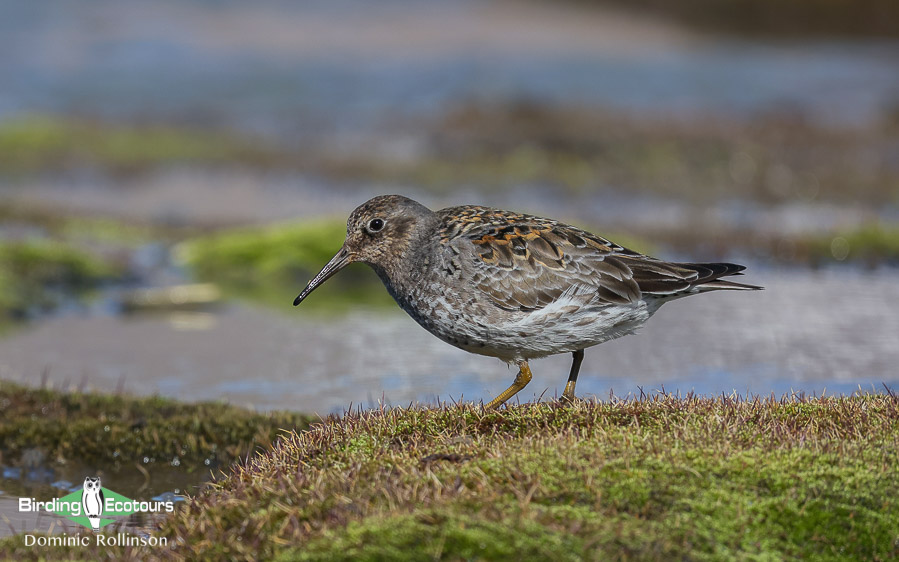
Day 11. Northumberland to Edinburgh
A final morning’s birding along the Northumberland Coast, where, tidal conditions permitting, we may call in at Holy Island (the mudflats here are likely to have an interesting assortment of shorebirds present e.g. Grey Plover, Bar-tailed Godwit, and Common Redshank).
We will then drive north once more to Edinburgh, the Scottish capital city and home to some impressive castles and historic buildings. We will pay careful attention to the latest bird news, as rafts of Common Scoter may be joined by Velvet Scoter, Long-tailed Duck, Common Eider, or something much rarer like Black Scoter, Stejneger’s Scoter, King Eider, or White-winged Scoter are all possible, among many other species. We may have a little time available for sightseeing around Edinburgh and we can certainly look at the famous Edinburgh Castle.
Overnight: Edinburgh
Day 12. Edinburgh to Fort William
We head from Edinburgh in the east, to rugged western Scotland, where we will look for White-tailed Eagle, Golden Eagle, Black Guillemot, Hooded Crow, and Common Loon (Great Northern Diver) among other regional specials as our Scottish bird watching gets going in earnest.
Overnight: Fort William
Day 13. Fort William to Aviemore
We will drive northeast to Aviemore in the idyllic Scottish Highlands and will notice a changing birdlife. We will likely stop at a wetland site along the way, where we may find Osprey, and there is sure to be some interesting waterfowl too, maybe Common Goldeneye, Red-breasted Merganser, or Greater Scaup. The shores of the wetland may support Common Sandpiper, Green Sandpiper, Wood Sandpiper, or Common Greenshank at this time of year. We will arrive in Aviemore in the late afternoon and check into our hotel, which will form our base for the next five nights of Scotland bird watching.
Overnight: Aviemore
Days 14 – 17. Birding the Scottish Highlands
We will have four full days exploring the Scottish Highlands. Our base is in an ideal location for finding some of the Scottish specials, such as European Crested Tit, Scottish Crossbill, Parrot Crossbill, Horned Grebe (Slavonian Grebe), and Golden Eagle.
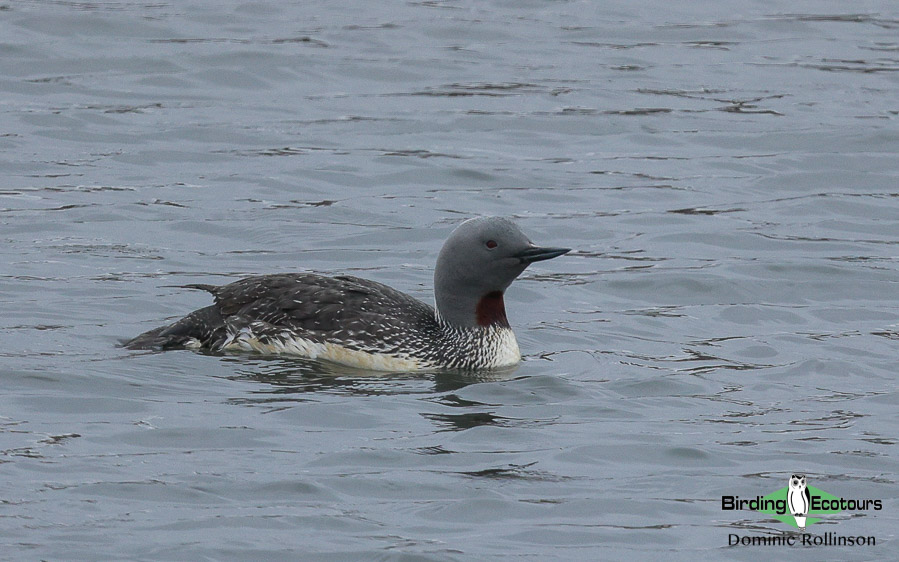
We will spend a couple of days getting the most out of the local area, where other birds we might find include Black Grouse, Red-throated Loon (Red-throated Diver), European Pied Flycatcher, Eurasian Nuthatch, Eurasian Treecreeper, and Spotted Flycatcher.
On one of the days in the area we will visit the Cairngorms plateau, where we will look for resident Willow Ptarmigan (Red Grouse), Rock Ptarmigan, and freshly arrived Eurasian Dotterel as they set up their territories for breeding, and as we search for these species we may find Twite, Snow Bunting, Ring Ouzel, and Northern Wheatear. Streams lower down the mountain may also hold White-throated Dipper and Grey Wagtail.
Overnight: Aviemore (four nights)
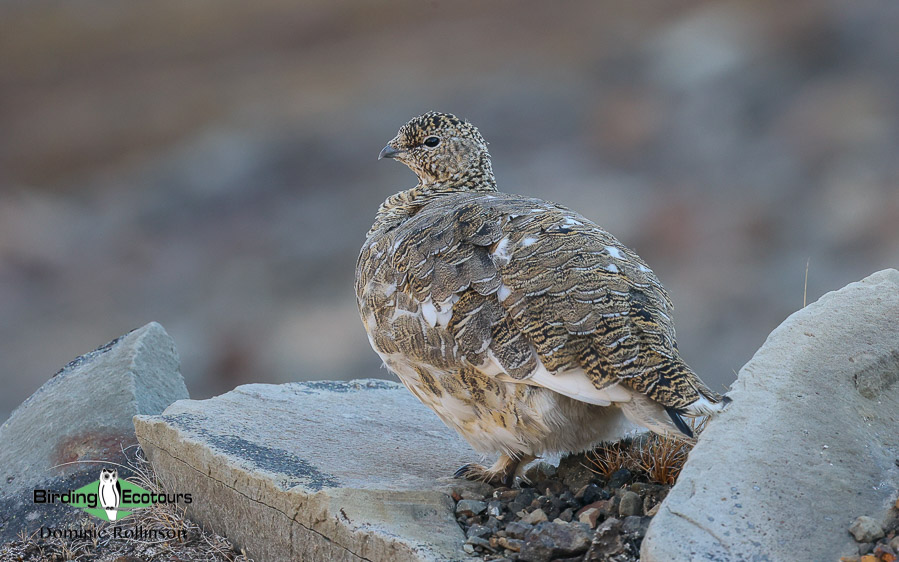
Day 18: Flight out of Inverness
After a final morning session of Scottish Highland birding, we will travel the hour or so to Inverness on the edge of Loch Ness, for our flights home and the tour will conclude at midday. We can also transfer you to Edinburgh if needed, if you want a cultural extension there or have better homeward flights from there.
Overnight: Not included
Please note that the itinerary cannot be guaranteed as it is only a rough guide and can be changed (usually slightly) due to factors such as availability of accommodation, updated information on the state of accommodation, roads, or birding sites, the discretion of the guides and other factors. In addition, we sometimes have to use a different international guide from the one advertised due to tour scheduling.
Download ItineraryUnited Kingdom: UK Spring Tour Trip Report, April 2024
28 APRIL – 20 MAY 2024
By Chris Lotz
DOWNLOAD TRIP REPORT
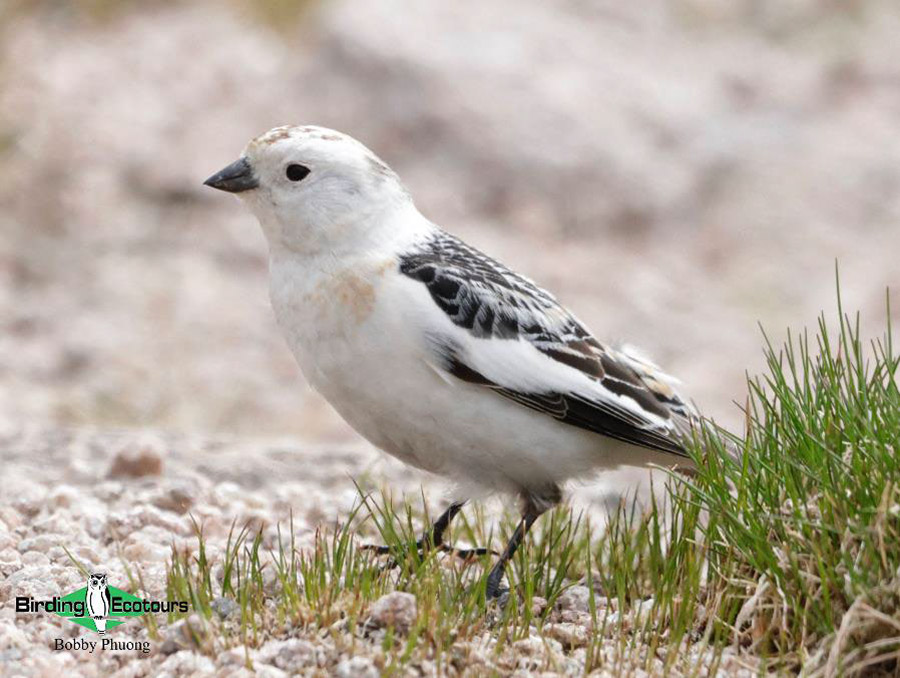
Overview
This was a wonderful 3.5 week birding, mammal and sightseeing tour of a large part of England and Scotland. During this tour, we saw a good proportion of Britain’s birds, mammals and other wildlife. The tour participants, Dan and Bobby, were great company and, being from New Zealand, most of the fauna was new for them, apart from a handful of British birds that have become established in their home country.
I fetched Bobby and Dan in London and we immediately headed to Knepp, famous for its rewilding. Here, we enjoyed White Storks and listened to the beautiful (and very loud!) songs of Common Nightingales, amongst numerous other birds. We then headed back to London for a bit of sightseeing and the Abba Voyage concert, which was even better than expected, what a spectacular show! We then headed west, visiting Glastonbury, Stonehenge and Highclere Castle where Downton Abbey was filmed (and the third movie is being filmed there as I write this!). We also saw some truly brilliant birds such as Great Bustards on the Salisbury Plain.
The proper birding began, after the more sightseeing-focused “pre-trip” described above, when we headed to Norfolk for five days. Norfolk and adjacent Suffolk in East Anglia are two of Britain’s best birding counties, and we thoroughly enjoyed visiting some of the famous bird reserves in this part of the world. These included the Royal Society for the Protection of Birds (RSPB) Titchwell and Minsmere reserves, and the Norfolk Wildlife Trust (NWT) Cley Marshes reserve.
Three nights in Yorkshire were next on the agenda. Here, we enjoyed seeing White-throated Dippers, Willow Ptarmigan (Red Grouse) and the spectacular seabird colony at RSPB Bempton Cliffs (huge numbers of Northern Gannets and other seabirds breed on the impressive sea cliffs here). Our last bit of birding in England (before heading for the Scottish Highlands) was in Northumberland, where we enjoyed seeing some Black Grouse en route. In Northumberland, we saw some excellent birds and were also treated to a spectacular display of the Northern Lights. There were other distractions from the birding, such as some impressive castles (e.g. the imposing Bamburgh Castle) and the fascinating Holy Island of Lindesfarne. One of the biggest highlights of the entire trip was, however, our boat trip to the Farne Islands, where we got wonderfully close to comical Atlantic Puffins, other beautiful, close-up alcids and various other breeding seabirds.

There were lots of great highlights (besides the birds and other wildlife) on this trip, including a superb Northern Lights show!
We then crossed the border into Scotland, skirting past Edinburgh and driving right through Glasgow, then through Loch Lomond and the Trossachs National Park. We eventually found ourselves at the Scottish Beaver Centre near Knapdale. This stunningly beautiful part of the world allowed us to see Eurasian Beavers, Red Squirrels, our first divers (loons) and lots more. We then headed to the Isle of Mull, part of the Inner Hebrides. This is eagle paradise, and we got great views of Golden Eagle at its eyrie, plus a White-tailed Eagle atop a hill. There were lots of other wonderful birds around in this spectacularly scenic part of the world, including a Surf Scoter visiting from North America.
After an all too short “Mull sampler” (just two nights), we then headed northeast, and spent the last five days of our epic trip around Aviemore to explore the Cairngorms National Park. The Caledonian Pine Forest, birchwoods and beautiful lochs here were a delight to explore and we added many excellent birds and mammals to our trip list. These included Snow Buntings in summer plumage, breeding Pied and Spotted Flycatchers, breeding Black-throated Loons (Divers) and many others.
I eventually dropped Dan and Bobby at Edinburgh airport for their flights home, after a spectacular introduction to British wildlife.
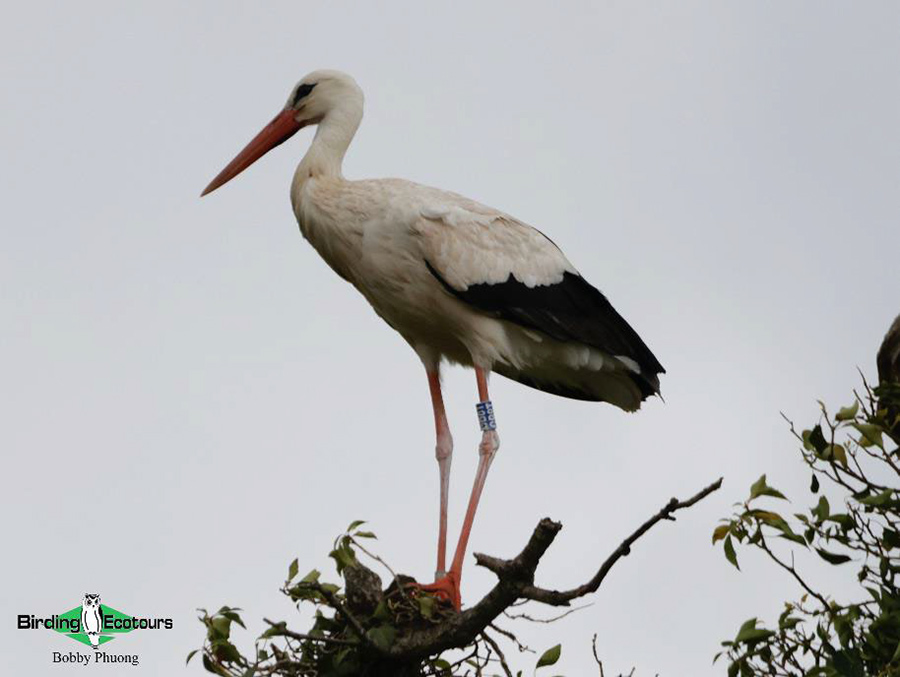
White Stork at Knepp.
Detailed Report
Day 1, 28th April 2024. Arrival in London and transfer to Knepp Rewilding Estate
I fetched Bobby and Dan from Heathrow airport and we immediately embarked on our drive southwards to the Knepp Rewilding Estate, the home of reintroduced White Storks and many other birds. Being from New Zealand and never having birded Britain before, most species were new, and we enjoyed encountering some of our first common English birds such as European Robin, Common Blackbird, White Wagtail, Dunnock, Eurasian Chaffinch, Eurasian Goldfinch, Common Linnet, Eurasian Wren, Song Thrush, Mistle Thrush, Eurasian Blue Tit, Long-tailed Tit, Common Wood Pigeon, Eurasian Collared Dove, Common Moorhen, Grey Heron, Eurasian Magpie, Eurasian Jay, Western Jackdaw, Rook and Carrion Crow. Several warbler species were around; there were many Common Chiffchaffs, Common Whitethroats and Lesser Whitethroats, plus we also found a plain-looking Garden Warbler. One of the star birds at Knepp, which we heard singing beautifully but only glimpsed a couple of times, was Common Nightingale.
European Green Woodpecker and Great Spotted Woodpecker both put in appearances here at Knepp. Raptors came in the form of Eurasian Sparrowhawk, a Common Kestrel and quite a number of beautiful Red Kites.
Our first mammals of the trip were Fallow Deer with nice antlers, European Rabbit and Grey Squirrel.
Day 2, 29th April 2024. Sightseeing and Abba concert in London
We had breakfast near the Worthing Pier on the south coast of England with a view across the English Channel. We got our first decent views of Herring Gull here.
We then headed into central London for some drive-by sightseeing. We drove past the Royal Albert Hall, Buckingham Palace, Westminster Abbey, Big Ben, London Bridge and Tower Bridge. We then headed to a different part of London to the purpose-built Abba Arena, near the Queen Elizabeth Olympic Park area, where we thoroughly enjoyed the spectacular Abba Voyage concert.
Day 3, 30th April 2024. The Salisbury Plain Great Bustards, and Highclere Castle
We embarked on a three-hour drive to the Salisbury Plain, site of Stonehenge and Great Bustards. We enjoyed over 20 bustards on a Great Bustard Group tour. We also saw other excellent birds during this tour, such as a Eurasian Stone-curlew, Northern Lapwing,a pair of close-up Grey Partridges, a few Red-legged Partridges, Corn Buntings, Common Linnets and many others. We also had excellent views of Meadow Pipit, Common Whitethroat, European Stonechat and White Wagtail.There were numerous Red Kites, a couple of Common Buzzards and a Common Kestrel around. Our first Barn Swallow of the trip flew low over.Mammal-wise, we saw some Roe Deer today, albeit a bit distant.
After checking into our bed and breakfast, we went to Highclere Castle where we thoroughly enjoyed the beautiful gardens, followed by an early evening tour of the inside of the building, the setting of Downton Abbey. We also looked at the ancient Egyptian museum section.
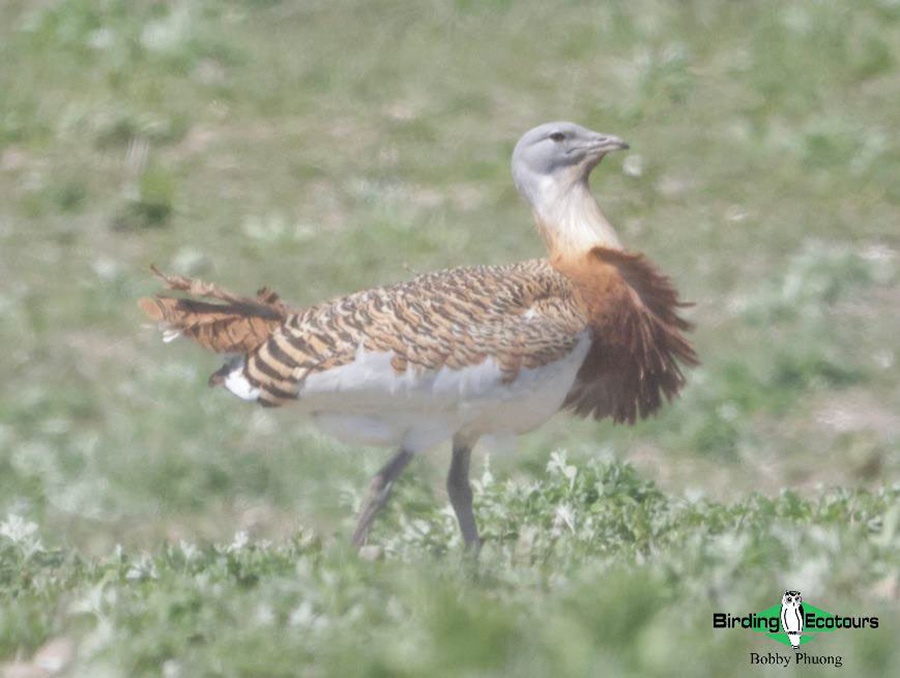
One of over 20 Great Bustards we saw.
Day 4, 1st May 2024. Stonehenge and Glastonbury
After breakfast at our pleasant guest farm accommodation, we took the five-minute drive to Stonehenge. Here, we enjoyed not only this prehistoric megalithic phenomenon made from sarsen stones, but also obtained close-up photographic views of the three more common corvids, Corn Buntings,a male Northern Wheatear, Eurasian Skylarks, and various other birds.
We then explored the town of Glastonbury, including Glastonbury Abbey (allegedly the site of King Arthur’s tomb and with birdy grounds where we saw some new trip birds such as European Greenfinch, Coal Tit and Great Tit at feeders), the site of the Glastonbury Festival, and Glastonbury Tor.
We then continued northwards, bypassing the western side of Bristol, with Wales visible in the distance, and stayed the night at Slimbridge.
Day 5, 2nd May 2024. To Norfolk, arguably Britain’s best birding county!
After an excellent breakfast, we headed to the amazing Cotswold Christmas shop (open year-round) in Lechlade-on-Thames, for an hour. We then embarked on the three-hour drive to the Welney Wetland Centre in western Norfolk near the Cambridgeshire county line. The highlight here was a couple of late Whooper Swans (large flocks of these overwinter here but almost all of them are gone by early May) among large numbers of Mute Swans. We also saw many other new trip birds including Greylag Goose, Common Shelduck, Northern Shoveler, Gadwall, Eurasian Wigeon (these also overwinter in Norfolk in large numbers, but again only a handful remain by early May), Common Pochard, Tufted Duck, Stock Dove, Eurasian Coot, Great Crested Grebe, Eurasian Oystercatcher, Pied Avocet, beautiful breeding plumage Black-tailed Godwit, Common Sandpiper, Common Redshank, Black-headed Gull, Little Egret, Great Egret, Western Marsh Harrier, Cetti’s Warbler and Sedge Warbler (poor views today but we’d see this species very well the next day). One of the target birds here was the scarce Eurasian Tree Sparrow, and we saw a couple of these quite close-up.We also heard the bizarre, deep booming of a Eurasian Bittern.
We then headed to Norwich, which we used as a base for the next five nights to further explore East Anglia.
Day 6, 3rd May 2024. Birding the northeast Norfolk coast
We only started birding in the late morning, and stopped mid-afternoon because of rain, but it was nevertheless another very productive day! We started in Salthouse where we saw and photographed some birds we’d already seen before, but this time really close-up. We then headed slightly further west to the famed Norfolk Wildlife Trust (NWT) Cley Marshes Nature Reserve. We were pleased to add many more new trip birds here. These included Brant Goose (another mainly winter species), Egyptian Goose, Common Swift, Little Grebe, Common Ringed Plover, neat Little Ringed Plover, Eurasian Curlew, a breeding plumage Bar-tailed Godwit (and more breeding plumage Black-tailed Godwits which we’d also seen the previous day), Common Gull (which is actually not particularly common), a flock of five Eurasian Spoonbill flying over, Sand Martin, Common Reed Warbler and some stunning Common Reed Buntings.
We then went to the Sheringham area to look for Firecrest, and were not disappointed, getting eye level views.
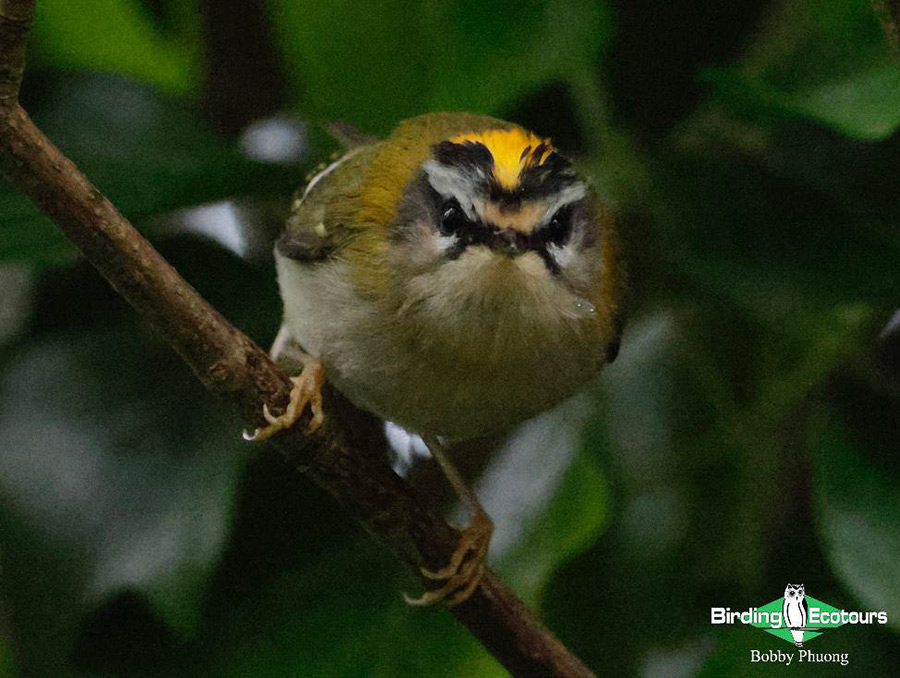
An eye level Firecrest is always a delight to see.
Day 7, 4th May 2024. Birding RSPB Minsmere and other Suffolk birding sites
We started the day at Walberswick on the Suffolk coast, where we saw flocks of Common Scoters out at sea, two Eurasian Whimbrels,some Dunlins in the marshes, a close-up Common Kestrel, and a few other species. We then went to Saxmundham, where Bohemian Waxwings had been present for over a week, but these had sadly gone now, as we discovered. We finally headed to the Royal Society for the Protection of Birds (RSPB) Minsmere nature reserve for the rest of the day. Here at Minsmere, we quickly found a number of new trip birds like Barnacle Goose, Common Tern, Sandwich Tern, Black-legged Kittiwake and Eurasian Blackcap. We then went to the Bittern Hide where we were treated to five Eurasian Bittern sightings as they flew by, many Western Marsh Harriers quartering low over the reeds and some other good birds. On the way back to the visitor center, we saw a cute little deer, Reeve’s Muntjac.
We ended the day at Dunwich Heath, where we saw some Dartford Warblers.
Day 8, 5th May 2024. Birding RSPB Titchwell and Sculthorpe Moore nature reserves
We had a wonderful session at Titchwell, a famous birding reserve in north-western Norfolk. Arguably the best highlight here was seeing Bearded Reedlings nicely. But we sure did also enjoy all the other bird species that were around. These included Mediterranean Gull, Common Cuckoo, some Great Crested Grebes on the calm sea, Eurasian Curlews, a few Sanderlings and many Ruddy Turnstones on the beach.
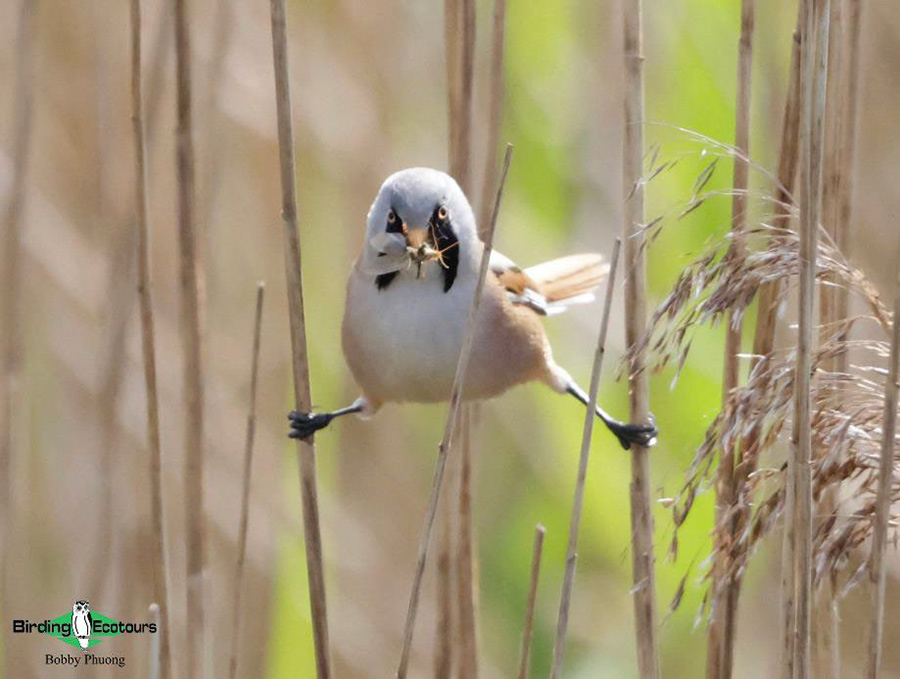
One of the Bearded Reedlings we saw at Titchwell.
We then visited Sculthorpe Moor Nature Reserve, where we enjoyed Tawny Owl at its nest box, Coal Tit, Marsh Tit, Grey Wagtail and various other new birds for the tour.
Day 9, 6th May 2024. Birding Hickling Broad Nature Reserve and Santon Downham
After breakfast, we headed to the largest of the Norfolk Broads, Hickling Broad, where our main target was Common Crane. After a bit of a wait, we eventually saw two flying in and landing, and we managed to scope them from a viewing platform. We also enjoyed listening to some close-up Eurasian Bitterns. About eight Great Egrets put on a flight show for us, as did some Western Marsh Harriers. We saw a gorgeously bright Yellowhammer clearly in freshly molted plumage, shining in the sun along a side road. We improved our views and photos of some species we’d already seen earlier in the trip, e.g. Long-tailed Tit and Eurasian Teal.
We then headed to the Horsey Windpump, where we found our first Willow Warblers of the trip.
We opted to end the day on the other (western) side of Norfolk – on the Suffolk county line – to look for Mandarin Duck. We enjoyed seeing four of these beautiful birds. Another highlight here was a close-up Grey Wagtail, a better view than we’d had previously.
We also saw a couple of non-avian critters today. Mammal-wise, we were pleased to see a Stoat running across the road in front of us, on our way to our first site. We also got brief views of a Palmate Newt.
Day 10, 7th May 2024. Drive to the York area via RSPB Frampton Marsh
We had a superb three or so hour session at RSPB Frampton Marsh in Lincolnshire, conveniently breaking the journey northwards from Norwich to York. A beautiful drake Garganey and quite a close-up Greenshank were two solid new trip birds. Just after enjoying these, we heard that the Red-breasted Goose that had been frequenting this reserve had just been found. We rushed to where it was and, after a bit of scanning, we picked this stunningly beautiful bird out from among a flock of Brant Geese. What a win! A superb-looking rarity. We got better views than previously of Whooper Swan and some Mediterranean Gulls, along with extremely close-up nesting Great Crested Grebes. All in all, not bad for a “travel day” in which we had to get to a new part of England.
Day 11, 8th May 2024. Birding the Howardian Hills, the North York Moors National Park and Scarborough
We started the day in the Castle Howard area, where we were pleased to find our first Goldcrest (albeit high up in a tree), Eurasian Treecreeper (much better views than the Goldcrest!), and a range of other birds we’d already seen earlier in the trip.
We then continued northwards to the North York Moors National Park, one of the largest areas of heather in the UK. Our main target bird at high elevation here was Willow Ptarmigan (the famous Red Grouse) and it co-operated very well. We also enjoyed seeing a close-up Eurasian Curlew on the moor.
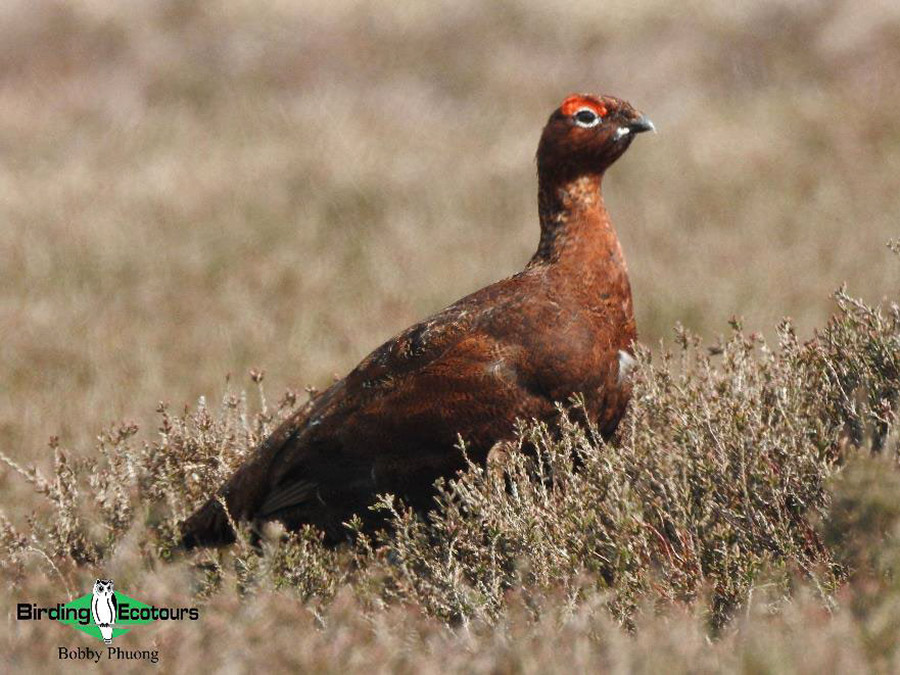
The famous grouse, i.e. the Red Grouse subspecies of Willow Ptarmigan.
Our next stop was in Grosmont (a quaint village and train station) in the valley below. Here, our main target, White-throated Dipper, showed extremely well, along with a pair of Grey Wagtails.
Our final stop for the day was Scarborough, where we saw our first Common Eider (a beautiful drake) and a few other birds.
Day 12, 9th May 2024. RSPB Bempton Cliffs, Filey Dams and Wheldrake Ings birding
Bempton Cliffs RSPB reserve is famous, for good reason. The spectacular sea cliffs are filled with breeding Northern Gannets, Black-legged Kittiwakes, Common Murres and Razorbills. We saw our first two Atlantic Puffins and a couple of Northern Fulmars as well. A pair of Grey Partridges and several Red-legged Partridges were in the grassy fields above the cliffs. We also enjoyed watching a Barn Owl, a couple of Corn Buntings and large numbers of Eurasian Tree Sparrows (generally a scarce bird in the UK).
After a nice lunch at Bempton Cliffs, we drove to the nearby Filey Dams to try and find a Long-tailed Duck that had been reported, but it was MIA. We did see some other nice birds there, but nothing new for the trip.
We ended the day at Weldrake Ings Nature Reserve, where again we found some good birds but nothing new for the tour. Unfortunately, we didn’t see (or hear the diagnostic call of) Willow Tit, our main target here.
Day 13, 10th May 2024. Drive to Northumberland via our Black Grouse site
Today was a fairly long transfer day to Northumberland in northeast England. We enjoyed several birding stops along the way, the best being at our Black Grouse site in the North Pennines Area of Outstanding Natural Beauty (AONB) where we encountered 13 of these handsome birds (all males). We also found another Willow Ptarmigan (Red Grouse) nearby for comparison.
An even bigger tour highlight than Black Grouse awaited us tonight as the Northern Lights (aurora borealis) showed very well – amazing! We saw predictions that it would be not only visible, but also good, in Northumberland, and we were not disappointed!
Day 14, 11th May 2024. Holy Island and Farne Islands boat trip
This was one of the best days of the whole trip. We started the day crossing the causeway onto Holy Island (Lindesfarne), a really spectacular place. On the causeway (that floods during high tide), we got good views of Dunlin, Common Ringed Plovers and Common Eiders, and distant views of breeding plumage Grey Plovers (a better name in this plumage is Black-bellied Plover, a strikingly beautiful bird), a couple of close flyby Little Terns, a few Sandwich Terns and various other birds. We then explored the town of Lindesfarne, the abbey area and the harbor. This is a fascinating place historically (see here for more about that) and it is also a good birding venue. On our way to the harbor, we were very pleased to see our first Common Merganser (Goosander) of the tour, as well as some birds we’d seen already.
After lunch, we joined an incredible boat trip to the Farne Islands. While waiting at the harbor for our boat trip to start, we saw a few Purple Sandpipers and various other good birds we’d seen before, such as Ruddy Turnstones and Common Eiders. We then took the boat to the islands and saw a few Northern Gannets and alcids as we approached the islands. The Farne Islands are inhabited by 90,000 Atlantic Puffins and we got to walk right near them, so we could even take cell phone photos. What a magnificent experience. Tens of thousands of Common Guillemots (Murres), a handful of them with attractive bridles, and Razorbills, also nest here. We enjoyed seeing a small flock of Arctic Terns and a number of Sandwich Terns flying around. Black-legged Kittiwakes, Great Black-backed, Lesser Black-backed, Herring and Black-headed Gulls were also out in force. We saw a single Northern Fulmar. Great Cormorants and breeding plumage European Shags were around.
Mammal-wise, we enjoyed spending some time with a colony of playful Grey Seals towards the end of our boat trip.
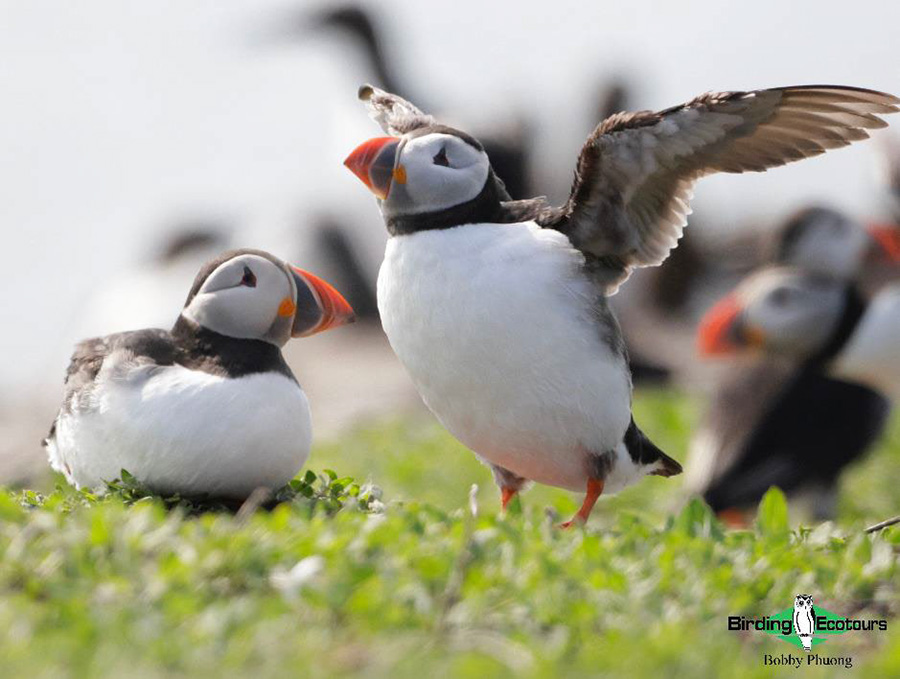
We enjoyed being surrounded by close-up Atlantic Puffins when we landed on the Farne Islands.
Day 15, 12th May 2024. Scottish Beaver Trail
We had a fairly long but very scenic drive today. We headed north and soon crossed the border into Scotland, stopping to take photos of the sign welcoming us to Scotland. We traveled around Edinburgh and then westwards, driving through Glasgow and finally into the scenically spectacular Loch Lomond and the Trossachs National Park. We eventually reached our hotel, which afforded spectacular views from our rooms. We scoped the calm sea from the hotel and found some great new trip birds in the form of summer plumage Common Loon (Great Northern Diver), Red-throated Loon (Diver) distantly, a pair of Red-breasted Mergansers and our first Black Guillemot.
We then went to the Knapdale Scottish Beaver Trail Visitor Centre where we saw a Bank Vole, a Red Squirrel, many Eurasian Siskins, a close-up pair of Great Spotted Woodpeckers and a close-up Eurasian Nuthatch at the feeders. After a visit to Lochgilphead (where we saw our first Hooded Crows for the trip) and dinner, we returned here for an evening session, where we enjoyed seeing two Eurasian Beavers and a Eurasian Otter. Awesome!
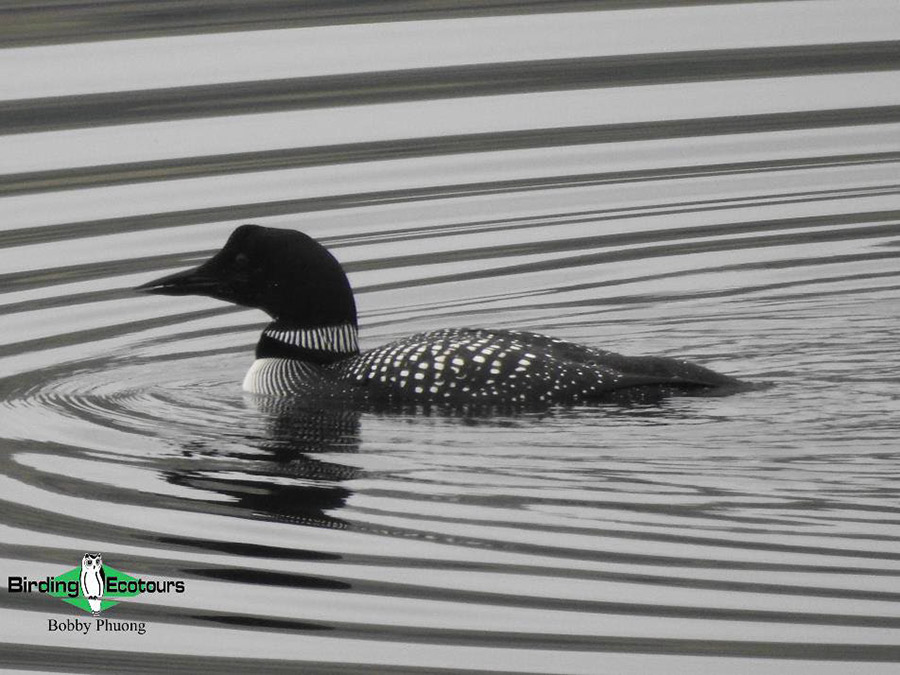
Scotland is great for breeding plumage loons (divers) in spring. This is a Common Loon (Great Northern Diver).
Day 16, 13th May 2024. Ferry crossing to the island of Mull!
We drove from Crinan northwards to Oban where, excitingly, we took a ferry crossing to Mull, the second largest island (after Skye) of the Inner Hebrides. A number of striking summer plumage Black Guillemots showed well in the harbor as we awaited our ferry. A few Common Murres (Common Guillemots) were seen from the ferry.
After landing on Mull (after the hour-long ferry crossing) we had lunch, during which we were rewarded with close views of a displaying European Rock Pipit. We then drove across a chunk of the island, seeing some great wildlife! Species included good numbers of summer plumage Common Loon (Great Northern Diver), a beautiful male Common Merganser (Goosander) and several Red-breasted Mergansers, White-tailed Eagle, a pair of Northern Ravens and many Hooded Crows.
Day 17, 14th May 2024. Full day on the island of Mull
Despite light drizzle, this was a super-amazing day in which we must have covered around 60 % of the roads of the scenically spectacular island of Mull. As we traversed the island, we enjoyed many species we’d already seen on previous days, plus some new ones. Quite close-up singing Tree Pipits were a delight. We then saw a couple of Common (Harbor) Seals. One of the major highlights of the day was a good view of an American vagrant Surf Scoter that had been present for at least a week, according to rare bird reports.
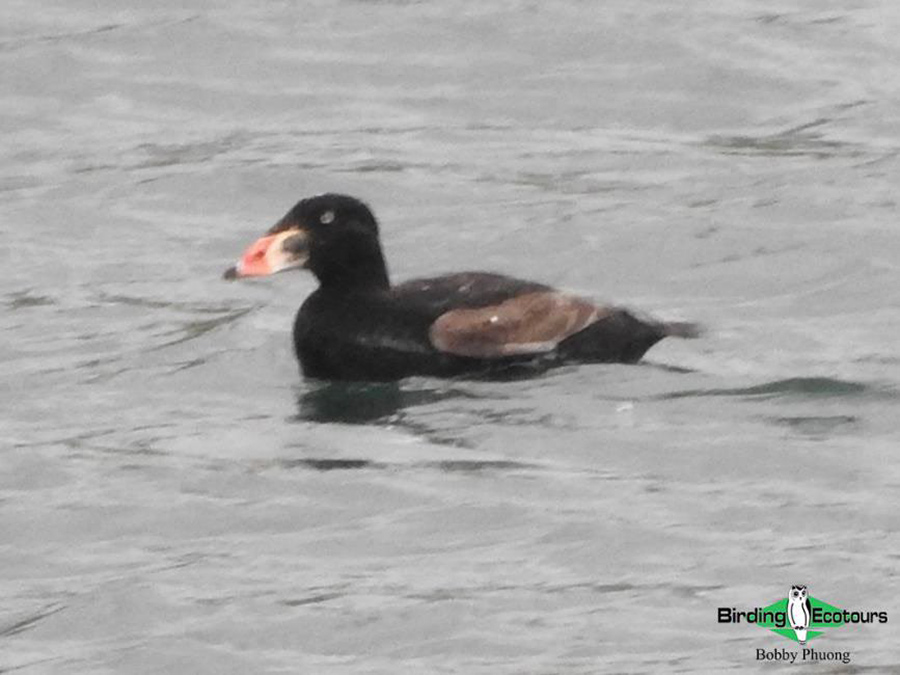
An American vagrant in Scotland, Surf Scoter.
Day 18, 15th May 2024. Mull to Aviemore
After yesterday’s drizzle, we were pleased to wake up to a warm sunshiny day. We were rewarded with good views of a Golden Eagle near its nest. At one point this majestic bird sat in a small tree, then on different rocks after a couple of short flights. We glimpsed its partner on the nest itself, but most of the time it was invisible.
We had to leave the island around lunchtime to comfortably make it to our next destination in a different part of Scotland before dinner, including time for birding stops. We traversed spectacular scenery and did two more ferry crossings (Fishnish to Lochaline and Ardgour to Corran), off the island of Mull and northeastwards on our way to the Cairngorms National Park area where we would spend the last five nights of our trip. Shortly after the second ferry, we found a small flock of Northern Ravens.En route towards Fort William, the last west coast town before we headed inland, we stopped to look at a Wood Warbler we heard singing as we were driving. We also saw a Eurasian Treecreeper and various other woodland birds at this stop. Nearby, we enjoyed seeing some Red-throated Loons (Divers) and a few other nice species.
Day 19, 16th May 2024. Star mammals of the Aviemore area
We started the day among the Cairngorm Reindeer herd, one of the biggest trip highlights for Dan and Bobby who got to hand feed these gentle animals. After lunch, we took a break, noting we were going to have a late night tonight. After an early dinner, we set off around 6.30 pm for a short stint of evening birding at Avielochan. Here, we enjoyed seeing a superbly smart-looking breeding plumage Horned (Slavonian) Grebe, a Common Goldeneye, an Osprey, a Mistle Thrush and various other goodies. We then headed to our mammal hide for an amazing evening that finished around midnight. At this hide, we got close-up views of at least five European Badgers, a European Pine Marten, a Bank Vole and a few Wood Mice (Long-tailed Field Mice). We heard Eurasian Woodcock and Tawny Owl while at the hide. We just missed a Scottish Wildcat that some late arrivers to the hide saw in the carpark once we’d already settled into the hide.

Reindeer!
Day 20, 17th May 2024. High altitude birding
We spent a large part of the day doing the strenuous walk to the Cairngorm Ski Area and then beyond. The highlights were some beautiful summer plumage Snow Buntings, some rather distant male Ring Ouzels and a Mountain Hare. Very unfortunately, we narrowly missed Rock Ptarmigan, which others said had just been around.
Day 21, 18th May 2024. Birding RSBP Loch Garten Nature Reserve and Abernethy National Nature Reserve
We spent a relaxed day birding these beautiful forest reserves with their lovely lakes. We did not find any new birds or mammals for the trip, although we heard Crested Tit. We did get greatly improved views of some species, such as Goldcrest.
Day 22, 19th May 2024. Lochindorb, Nethy Bridge and Craigellachie National Nature Reserve
We started the day with a visit to Lochindorb, where we saw our target bird, a smart summer plumage Black-throated Loon (Diver), with ease. We also enjoyed seeing a couple more Willow Ptarmigans (Red Grouse) here. Just before getting to this loch, we also saw close up Common Cuckoos,which were very vocal too. The road goes straight through a breeding colony of Common Gulls, so we were surrounded by these neat birds.
We had lunch at Nethy Bridge, where we enjoyed close views of a White-throated Dipper feeding its baby. We then proceeded to Craigellachie Nature Reserve, where we obtained excellent views of a European Flycatcher and a quicker view of a Spotted Flycatcher. There were numerous other birds around which we’d seen before, such as Long-tailed Tits, stacks of Willow Warblers and a Eurasian Treecreeper, to name a few. We also saw hundreds of tadpoles, and a couple of Palmate Newts in the ponds.
Day 23, 20th May 2024. Transfer to Edinburgh airport for flights home
Sadly the tour came to an end with a transfer to the airport.

Some of the common British birds like this European Robin were major tour highlights.
Bird List – Following IOC 14.1
Birds ‘heard only’ are marked with (H) after the common name, all other species were seen.
The following notation after species names is used to show conservation status following BirdLife International: CR = Critically Endangered, EN = Endangered, VU = Vulnerable, NT = Near Threatened.
| Common name | Scientific name |
| Ducks, Geese, Swans (Anatidae) | |
| Brant Goose | Branta bernicla |
| Red-breasted Goose – VU | Branta ruficollis |
| Canada Goose | Branta canadensis |
| Barnacle Goose | Branta leucopsis |
| Greylag Goose | Anser anser |
| Mute Swan | Cygnus olor |
| Whooper Swan | Cygnus cygnus |
| Egyptian Goose | Alopochen aegyptiaca |
| Common Shelduck | Tadorna tadorna |
| Mandarin Duck | Aix galericulata |
| Garganey | Spatula querquedula |
| Northern Shoveler | Spatula clypeata |
| Gadwall | Mareca strepera |
| Eurasian Wigeon | Mareca penelope |
| Mallard | Anas platyrhynchos |
| Eurasian Teal | Anas crecca |
| Common Pochard – VU | Aythya ferina |
| Tufted Duck | Aythya fuligula |
| Common Eider | Somateria mollissima |
| Surf Scoter | Melanitta perspicillata |
| Common Scoter | Melanitta nigra |
| Common Goldeneye | Bucephala clangula |
| Common Merganser | Mergus merganser |
| Red-breasted Merganser | Mergus serrator |
| Pheasants & Allies (Phasianidae) | |
| Willow Ptarmigan | Lagopus lagopus |
| Black Grouse | Lyrurus tetrix |
| Grey Partridge | Perdix perdix |
| Common Pheasant | Phasianus colchicus |
| Red-legged Partridge | Alectoris rufa |
| Swifts (Apodidae) | |
| Common Swift | Apus apus |
| Bustards (Otididae) | |
| Great Bustard – EN | Otis tarda |
| Cuckoos (Cuculidae) | |
| Common Cuckoo | Cuculus canorus |
| Pigeons, Doves (Columbidae) | |
| Rock Dove | Columba livia |
| Stock Dove | Columba oenas |
| Common Wood Pigeon | Columba palumbus |
| Eurasian Collared Dove | Streptopelia decaocto |
| Rails, Crakes & Coots (Rallidae) | |
| Common Moorhen | Gallinula chloropus |
| Eurasian Coot | Fulica atra |
| Cranes (Gruidae) | |
| Common Crane | Grus grus |
| Grebes (Podicipedidae) | |
| Little Grebe | Tachybaptus ruficollis |
| Great Crested Grebe | Podiceps cristatus |
| Horned Grebe – VU | Podiceps auritus |
| Stone-curlews, Thick-knees (Burhinidae) | |
| Eurasian Stone-curlew | Burhinus oedicnemus |
| Oystercatchers (Haematopodidae) | |
| Eurasian Oystercatcher | Haematopus ostralegus |
| Stilts, Avocets (Recurvirostridae) | |
| Pied Avocet | Recurvirostra avosetta |
| Plovers (Charadriidae) | |
| Grey Plover | Pluvialis squatarola |
| Common Ringed Plover | Charadrius hiaticula |
| Little Ringed Plover | Charadrius dubius |
| Northern Lapwing | Vanellus vanellus |
| Sandpipers, Snipes (Scolopacidae) | |
| Eurasian Whimbrel | Numenius phaeopus |
| Eurasian Curlew | Numenius arquata |
| Bar-tailed Godwit | Limosa lapponica |
| Black-tailed Godwit | Limosa limosa |
| Common Sandpiper | Actitis hypoleucos |
| Eurasian Woodcock (H) | Scolopax rusticola |
| Common Redshank | Tringa totanus |
| Common Greenshank | Tringa nebularia |
| Ruddy Turnstone | Arenaria interpres |
| Sanderling | Calidris alba |
| Dunlin | Calidris alpina |
| Purple Sandpiper | Calidris maritima |
| Gulls, Terns, Skimmers (Laridae) | |
| Little Tern | Sternula albifrons |
| Arctic Tern | Sterna paradisaea |
| Common Tern | Sterna hirundo |
| Sandwich Tern | Thalasseus sandvicensis |
| Black-legged Kittiwake – VU | Rissa tridactyla |
| Black-headed Gull | Chroicocephalus ridibundus |
| Mediterranean Gull | Ichthyaetus melanocephalus |
| Common Gull | Larus canus |
| European Herring Gull | Larus argentatus |
| Great Black-backed Gull | Larus marinus |
| Lesser Black-backed Gull | Larus fuscus |
| Auks (Alcidae) | |
| Atlantic Puffin – VU | Fratercula arctica |
| Black Guillemot | Cepphus grylle |
| Razorbill | Alca torda |
| Common Murre | Uria aalge |
| Loons (Gaviidae) | |
| Red-throated Loon | Gavia stellata |
| Black-throated Loon | Gavia arctica |
| Common Loon | Gavia immer |
| Petrels, Shearwaters, Diving Petrels (Procellariidae) | |
| Northern Fulmar | Fulmarus glacialis |
| Storks (Ciconiidae) | |
| White Stork | Ciconia ciconia |
| Gannets, Boobies (Sulidae) | |
| Northern Gannet | Morus bassanus |
| Cormorants, Shags (Phalacrocoracidae) | |
| Great Cormorant | Phalacrocorax carbo |
| European Shag | Gulosus aristotelis |
| Ibises, Spoonbills (Threskiornithidae) | |
| Eurasian Spoonbill | Platalea leucorodia |
| Herons, Bitterns (Ardeidae) | |
| Eurasian Bittern | Botaurus stellaris |
| Little Egret | Egretta garzetta |
| Great Egret | Ardea alba |
| Grey Heron | Ardea cinerea |
| Ospreys (Pandionidae) | |
| Osprey | Pandion haliaetus |
| Kites, Hawks, Eagles (Accipitridae) | |
| Golden Eagle | Aquila chrysaetos |
| Eurasian Sparrowhawk | Accipiter nisus |
| Western Marsh Harrier | Circus aeruginosus |
| Red Kite | Milvus milvus |
| White-tailed Eagle | Haliaeetus albicilla |
| Common Buzzard | Buteo buteo |
| Barn Owls (Tytonidae) | |
| Western Barn Owl | Tyto alba |
| Owls (Strigidae) | |
| Tawny Owl | Strix aluco |
| Woodpeckers (Picidae) | |
| Great Spotted Woodpecker | Dendrocopos major |
| European Green Woodpecker | Picus viridis |
| Caracaras, Falcons (Falconidae) | |
| Common Kestrel | Falco tinnunculus |
| Eurasian Hobby | Falco subbuteo |
| Old World Parrots (Psittaculidae) | |
| Rose-ringed Parakeet | Psittacula krameri |
| Crows, Jays (Corvidae) | |
| Eurasian Jay | Garrulus glandarius |
| Eurasian Magpie | Pica pica |
| Western Jackdaw | Coloeus monedula |
| Rook | Corvus frugilegus |
| Carrion Crow | Corvus corone |
| Hooded Crow | Corvus cornix |
| Northern Raven | Corvus corax |
| Tits, Chickadees (Paridae) | |
| Coal Tit | Periparus ater |
| Crested Tit (H) | Lophophanes cristatus |
| Marsh Tit | Poecile palustris |
| Eurasian Blue Tit | Cyanistes caeruleus |
| Great Tit | Parus major |
| Bearded Reedling (Panuridae) | |
| Bearded Reedling | Panurus biarmicus |
| Larks (Alaudidae) | |
| Eurasian Skylark | Alauda arvensis |
| Swallows, Martins (Hirundinidae) | |
| Sand Martin | Riparia riparia |
| Barn Swallow | Hirundo rustica |
| Western House Martin | Delichon urbicum |
| Cettia Bush Warblers & Allies (Cettiidae) | |
| Cetti’s Warbler | Cettia cetti |
| Bushtits (Aegithalidae) | |
| Long-tailed Tit | Aegithalos caudatus |
| Leaf Warblers (Phylloscopidae) | |
| Wood Warbler | Phylloscopus sibilatrix |
| Willow Warbler | Phylloscopus trochilus |
| Common Chiffchaff | Phylloscopus collybita |
| Reed Warblers & Allies (Acrocephalidae) | |
| Sedge Warbler | Acrocephalus schoenobaenus |
| Common Reed Warbler | Acrocephalus scirpaceus |
| Sylviid Babblers (Sylviidae) | |
| Eurasian Blackcap | Sylvia atricapilla |
| Garden Warbler | Sylvia borin |
| Lesser Whitethroat | Curruca curruca |
| Common Whitethroat | Curruca communis |
| Dartford Warbler | Curruca undata |
| Goldcrests, Kinglets (Regulidae) | |
| Common Firecrest | Regulus ignicapilla |
| Goldcrest | Regulus regulus |
| Wrens (Troglodytidae) | |
| Eurasian Wren | Troglodytes troglodytes |
| Nuthatches (Sittidae) | |
| Eurasian Nuthatch | Sitta europaea |
| Treecreepers (Certhiidae) | |
| Eurasian Treecreeper | Certhia familiaris |
| Starlings, Rhabdornises (Sturnidae) | |
| Common Starling | Sturnus vulgaris |
| Thrushes (Turdidae) | |
| Song Thrush | Turdus philomelos |
| Mistle Thrush | Turdus viscivorus |
| Common Blackbird | Turdus merula |
| Chats, Old World Flycatchers (Muscicapidae) | |
| Spotted Flycatcher | Muscicapa striata |
| European Robin | Erithacus rubecula |
| Common Nightingale | Luscinia megarhynchos |
| European Pied Flycatcher | Ficedula hypoleuca |
| European Stonechat | Saxicola rubicola |
| Northern Wheatear | Oenanthe oenanthe |
| Dippers (Cinclidae) | |
| White-throated Dipper | Cinclus cinclus |
| Old World Sparrows, Snowfinches (Passeridae) | |
| Eurasian Tree Sparrow | Passer montanus |
| House Sparrow | Passer domesticus |
| Accentors (Prunellidae) | |
| Dunnock | Prunella modularis |
| Wagtails, Pipits (Motacillidae) | |
| Grey Wagtail | Motacilla cinerea |
| White Wagtail | Motacilla alba |
| Meadow Pipit | Anthus pratensis |
| Tree Pipit | Anthus trivialis |
| European Rock Pipit | Anthus petrosus |
| Finches, Euphonias (Fringillidae) | |
| Eurasian Chaffinch | Fringilla coelebs |
| European Greenfinch | Chloris chloris |
| Common Linnet | Linaria cannabina |
| European Goldfinch | Carduelis carduelis |
| Eurasian Siskin | Spinus spinus |
| Longspurs, Snow Buntings (Calcariidae) | |
| Snow Bunting | Plectrophenax nivalis |
| Buntings (Emberizidae) | |
| Corn Bunting | Emberiza calandra |
| Yellowhammer | Emberiza citrinella |
| Common Reed Bunting | Emberiza schoeniclus |
| Total seen | 163 |
| Total heard only | 2 |
| Total recorded | 165 |
Mammal List – Following Mammalwatching.com
| Common name | Scientific name | |
| Hares and Rabbits (Leporidae) | ||
| European Hare | Lepus europaeus | |
| Mountain Hare | Lepus timidus | |
| European Rabbit – EN | Oryctolagus cuniculus | |
| Squirrels (Sciuridae) | ||
| Eastern Gray Squirrel | Sciurus carolinensis | |
| Eurasian Red Squirrel | Sciurus vulgaris | |
| Beavers (Castoridae) | ||
| Eurasian Beaver | Castor fiber | |
| Hamsters, Voles, Lemmings, and Allies (Cricetidae) | ||
| Bank Vole | Clethrionomys glareolus | |
| Old World Mice and Rats (Muridae) | ||
| Long-tailed Field Mouse | Apodemus sylvaticus | |
| Brown Rat | Rattus norvegicus | |
| Mustelids (Mustelidae) | ||
| European Pine Marten | Martes martes | |
| Eurasian Otter | Lutra lutra | |
| European Badger | Meles meles | |
| Beringian Ermine | Mustela erminea | |
| Earless Seals (Phocidae) | ||
| Gray Seal | Halichoerus grypus | |
| Harbor Seal | Phoca vitulina | |
| Deer (Cervidae) | ||
| Western Roe Deer | Capreolus capreolus | |
| Caribou – VU | Rangifer tarandus | |
| Western Red Deer | Cervus elaphus | |
| Common Fallow Deer | Dama dama | |
| Reeves’s Muntjac | Muntiacus reevesi | |
| Oceanic Dolphins (Delphinidae) | ||
| Common Bottlenose Dolphin | Tursiops truncatus | |
| Total seen | 21 | |
DOWNLOAD TRIP REPORT
This is a sample trip report. Please email us ([email protected]) for more trip reports from this destination.
UNITED KINGDOM: ULTIMATE SPRING TOUR
TOUR-SPECIFIC INFORMATION
GENERAL INFORMATION ABOUT THE UNITED KINGDOM CAN BE READ HERE
TOUR OUTLINE
This small group, set departure United Kingdom (UK) spring tour will start in London (Heathrow), England and end in Edinburgh, Scotland. The tour is timed during the peak of the spring migration within the UK and when breeding for a number of species will also be well underway. This comprehensive tour will connect with a wide range of rare and localized breeding species and will spend time focusing on the famed “Scottish Specials”, species not found further south in England, such as Golden Eagle, Rock Ptarmigan, Western Capercaillie, European Crested Tit, and Scottish Crossbill.
WEATHER/CLIMATE
Spring is generally a calm, cool season, particularly because the Atlantic has lost much of its heat throughout the autumn and winter period. As the sun rises higher in the sky and the days get longer, temperatures slowly rise, but the solar effect is mitigated by the effect of the cool ocean waters and westerly winds that blow across them. The average nighttime temperature in the UK in spring is 44 °F (7 °C), with the daytime temperature average of 60 °F (16 °C). We will be making several early morning starts, visiting northern latitudes, and spending some time at higher elevations on this tour, so we will likely experience a wide range of temperatures (see more below).
DAILY ACTIVITIES, PHYSICAL REQUIREMENTS, AND TOUR PACE
This tour covers a large part of the eastern UK and is at a faster pace than some of our other tours, for example our United Kingdom: England in Winter Tour is a slower-paced and less intensive birdwatching tour, with a different set of birds possible.
During this spring tour, sunrise will be around 05:00hrs and sunset around 21:30hrs, the tour will require some early starts and late finishes to our days in the field.
Most of the English leg of the tour is spent in the lowlands and at sea-level, though we will spend time in higher elevations, but these elevations are still rather low and are unlikely to provide any constraints to anyone. We will venture to higher ground (around 3,300 feet / 1,000m) when birding in the Scottish Highlands, potentially a little higher, briefly.
Much of our birding will be undertaken at established nature reserves, such as those managed and operated by the Royal Society for the Protection of Birds (RSPB) and regional wildlife trusts and organizations, such as Norfolk Wildlife Trust, Yorkshire Wildlife Trust, and Northumberland Wildlife Trust in England, among others, such as the Scottish Wildlife Trust. Most of the reserves we visit have good facilities, such as trail networks, viewing blinds (hides), and visitor centers often (including gift shops and cafes) though we will also be walking on rough tracks at times. Please note that the further north we go (such as when birding in Scotland), we will be spending more time on rougher tracks and will spend time walking some hills, though we will go at a pace suitable for everyone in the group.
The nature reserves we visit often allow great views of many species and can also offer good photographic opportunities, though please note that this set departure tour is not designed as a photographic tour, if you would like a custom photography tour for you or a group of friends, please let us know, as we can put together something specific for you.
DOMESTIC FLIGHTS
There are no domestic flights included in this tour. Note the tour starts in London (Heathrow), England and ends in Edinburgh, Scotland.
ACCOMMODATION
We will be staying in comfortable bed-and-breakfast (B&B) accommodation for most of the tour, with the exception of the beginning/end of the tour when we overnight in a hotel in London/Edinburgh. All accommodation has private rooms and bathroom facilities.
WHAT TO BRING: CLOTHING
In addition to the clothing mentioned in the general information document, a ‘midge net hat’ is recommended for when we are birding in Scotland. Although this tour takes place in late-spring, suitable clothing for cool mornings and evenings is recommended and rain should be expected at any time, so good waterproof clothing is necessary. Sturdy walking boots are recommended for this tour.
WHAT TO BRING: OTHER ITEMS
A walking/hiking stick will be useful for walking in some areas on this tour, such as when in Scotland.
‘England in Spring is the fifth tour I’ve done with BE, and this one was up to your usual standards. With our guide, we saw all the hotspots, and his expertise with the birds and habitats was impeccable. The lodgings were fascinating, as was the driving time, seeing the beautiful character of the English countryside. This is a wonderful tour of the UK during spring migration.’
William
